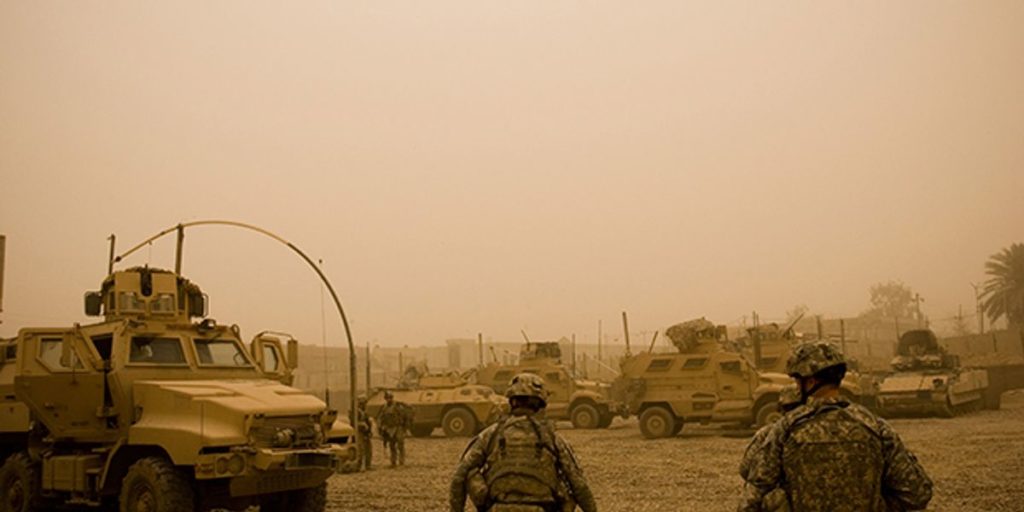“We went into an intersection, and the EFP went off and went right through our vehicle,” says the deputy commander of the Gulf Region Central District of the U.S. Army Corps of Engineers in Iraq. At the time of the attack, he was south of Baghdad, in a heavily armored vehicle called a Wolf. “The molten metal came up underneath us, and there were a few shrapnel pieces that were inside the compartment. But, for the most part, it missed us.” Even so, he was bleeding internally so badly that he had to be flown to Germany, where his life was saved by an 8-hour operation that put in 600 internal stitches. It was the fifth IED attack he’d survived, and by far the worst.
It was a classic explosively formed penetrator attack: the target was an armored vehicle, and the projectiles were fired at close range, in this case from below the vehicle.
EFPs are associated particularly with Shia militia groups. The U.S. military has long contended that Iran is a supplier of the EFP’s key component—a concave copper disk, called a liner, that must be properly machined to work well. This disk is fitted to one end of a metal tube that’s slightly longer than the diameter of the disk. The tube is packed with a plasticized military explosive, typically one containing cyclotrimethylenetrinitramine, also known as RDX. Its detonation releases an extremely fast-moving shock wave, which turns the liner into hot, explosively formed fragments moving at one to two kilometers per second—faster than a high-velocity rifle round. The kinetic energy of the fragments is so high that it penetrates most kinds of armor.
EFPs are usually triggered by a passive infrared sensor. The triggering system also often has a radio-control override that lets the triggerman enable the system when he sees a vehicle coming that he wants to attack. The infrared sensor then detects the heat of the passing vehicle and detonates the device. The U.S. military has contended that the radio-control systems also come from Iran.
The EFP is a textbook case of measure-countermeasure–counter-countermeasure. For a time, coalition vehicles sought to throw off the EFP’s infrared trigger with a simple countermeasure called a rhino, basically a hot glow plug in a metal can affixed to the front of the vehicle by a rod of variable length. It reduced the effectiveness of EFPs but not decisively so, because the attackers varied the timing of the detonation to try to counteract the rhino.
The triggering system, generally the only complicated part of an IED, remains the focus of strenuous countermeasures because it is pretty much the only component you can attack with technology. Early on, in 2003 and 2004, most IEDs in Iraq and Afghanistan were triggered wirelessly, often with cellphones, long-range cordless phones, key fobs, walkie-talkies, and wireless doorbells.
Relying on modified existing hardware and Navy expertise, JIEDDO’s predecessor quickly fielded jamming systems. Installed in vehicles, the jammers provide a bubble of safety around the vehicle, within which radio-frequency power overwhelms any signal being transmitted to an IED’s wireless trigger.
The jammer program became known as CREW, for “counter radio-controlled IED electronic warfare.” The latest jammers designed for U.S. vehicles are code-named Jukebox and CVRJ and are manufactured by EDO Corp. and other companies. They cost upwards of $80 000 apiece. All told, the U.S. military spent about $2 billion on jammers in 2007.
The insurgents’ response to the first jammers, in late 2003, was swift. It established a Spy vs. Spy–like competition between counter-IED specialists and the bomb makers, in which sometimes a measure was followed by a countermeasure within days.
As jammers proliferated, insurgent groups quickly went back to using command wires—buried pairs of long enameled copper wires attached to a simple switch—and also to “victim-operated” triggers. These triggers, also usually buried for concealment, include pressure plates and crush wire—flexible tubing with two conductors inside that touch and make an electrical connection when the tubing is squashed by a tire or a foot.


